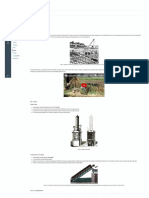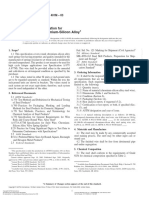100%(1)100% found this document useful (1 vote)
162 viewsConveyors History
Conveyors History
Uploaded by
JOSEPH REFUERZOCopyright:
© All Rights Reserved
Available Formats
Download as PDF or read online from Scribd
Conveyors History
Conveyors History
Uploaded by
JOSEPH REFUERZO100%(1)100% found this document useful (1 vote)
162 views17 pagesOriginal Title
conveyors-history
Copyright
© © All Rights Reserved
Available Formats
PDF or read online from Scribd
Share this document
Did you find this document useful?
Is this content inappropriate?
Copyright:
© All Rights Reserved
Available Formats
Download as PDF or read online from Scribd
Download as pdf
100%(1)100% found this document useful (1 vote)
162 views17 pagesConveyors History
Conveyors History
Uploaded by
JOSEPH REFUERZOCopyright:
© All Rights Reserved
Available Formats
Download as PDF or read online from Scribd
Download as pdf
You are on page 1of 17
OQ @ tipinstructurecom/courses/t (8)
The beginning of
Conveyors
Conveyor belts and systems go back
pretty far in time, helping to ensure
the manufacturing industry has been
able to prosper and grow. Here we're
looking back into the history of
conveyors and how they’ve developed
since their earliest days.
Conveyors are essential to quarrying,
mining, and mineral processing
operations, but we sometimes take
them for granted. Did you know that it
was not so long ago in human history
that these hardworking machines
didn’t exist? Imagine your surface or
open-pit mining operation without any
conveyors — things would not be
moving very quickly or efficiently, and
the whole undertaking would be a lot
more dangerous!
To show conveyors a little
Scanned with CamScanner
To show conveyors a little
appreciation, we're taking a look at
their history from their roots in the
late 1700s through decades of
improvement and innovation that
transformed them into the reliable
machines we depend on today.
The earliest
conveyors
If conveyors have a single inventor or
first installation site, that information
has sadly been lost to time. What is
known is that while Henry Ford made
conveyors famous with his automobile
assembly lines in the early
20" century, he did not invent them (as
many people incorrectly believe) - he
just improved upon old technology.
In fact, various sources point to 1795
as the year when conveyors first
appeared. These early conveyors were
short, made from leather belts and
wooden beds, and were hand-
operated. They were mainly used in
ports to move agricultural products
fram chara ta chin
Scanned with CamScanner
The earliest
conveyors
If conveyors have a single inventor or
first installation site, that information
has sadly been lost to time. What is
known is that while Henry Ford made
conveyors famous with his automobile
assembly lines in the early
20th century, he did not invent them (as
many people incorrectly believe) - he
just improved upon old technology.
In fact, various sources point to 1795
as the year when conveyors first
appeared. These early conveyors were
short, made from leather belts and
wooden beds, and were hand-
operated. They were mainly used in
ports to move agricultural products
from shore to ship.
First Invented
The first
primitive
and basic
conveyor
belts were
invented
Scanned with CamScanner
First Invented
The first
primitive
and basic
conveyor
belts were
invented
and used in
the
19% centur
y, with
some basic
systems even seen in the late
18" century. A key moment came in
1892 when Thomas Robins, an
American inventor, began a series of
developments that ended with a
conveyor belt that began to be used to
carry coal, ores, and other related
materials.
By 1901 the Swedish engineering company
Sandvik started the production of the first
steel conveyor belts and by 1905 Irish-born
but Yorkshire-based engineer Richard
Sutcliffe invented the first conveyor belts to
be used in coal mines. They completely
revolutionized the mining industry making it
more efficient.
Scanned with CamScanner
Rails are out,
conveyors are in
With Sutcliffe’s underground conveyor
belt, mining and quarrying were
revolutionized over the following few
decades, as massive quantities of
material could now be moved from the
extraction point with much less labor.
No longer did expensive rail lines need
to be laid and maintained. And when a
mine’s LOM (expected life of the mine)
was over, a conveyor was much easier
to pack up and remove than a rail line,
which was pretty much permanent.
It did take some good publicity to
popularize conveyors, however, as
news of technical innovations didn’t
spread as quickly back then as it does
today. Plus, it certainly was not as easy
to purchase and set up conveyors in
the early days.
In 1908, inventor Hymle Goddard
patented the first roller conveyor, and
then things really started to get
moving. Henry Ford famously began
using conveyors on the assembly lines
in his automobile plants around 1913,
and soon problem-solvers in countless
Scanned with CamScanner
In 1908, inventor Hymle Goddard
patented the first roller conveyor, and
then things really started to get
moving. Henry Ford famously began
using conveyors on the assembly lines
in his automobile plants around 1913,
and soon problem-solvers in countless
industries began refining conveyors
and inventing new types, as well. In the
quarrying, mining, and mineral
processing industries, conveyors were
quickly replacing the locomotive and
rail lines throughout the 1920s until
the outbreak of war in the 1940s.
Industrial revolution
+ Invention
sand
developm
ents
g continued
, with
a Henry
Ford
introducin
&
= conveyor-
belt assembly lines at the Highland
Scanned with CamScanner
Invention
sand
developm
ents
continued
, with
y Henry
Ford
introducin
g
ess y: conveyor-
belt assembly lines at the Highland
Park, Michigan factory of Ford Motors
in 1913 and by 1957 the B.F.
Goodrich Company managed to patent a
specific conveyor belt, which was soon
produced and sold as the Turnover Conveyor
Belt System. It featured a half-twist element
which allows it to perform better than
standard belts due to its longer life span.
Plastics became a regular featuring in belting
by the 1970s, with Louisiana-based
Company Intralox registering the first patent
for all plastic, modular belting.
Leather to
Snecialiced
Scanned with CamScanner
Leather to
Specialised
Synthetics
The very
first
conveyor
belts
created
were
mainly
constructed from leather, canvas and
rubber. They were set across wooden
systems which allowed them to move
with ease and create the conveyor
movement necessary for the
transportation of mainly mined goods.
The modern conveyor belt is
constructed from a special
combination of synthetic materials,
polymers, and different fabrics, and
they are now designed to remove the
need for expensive maintenance to the
belt at all.
Conveyor Belts to
Remember
Scanned with CamScanner
Conveyor Belts to
Remember
Back in 1972, the concept designer
Hyacinthe Marcel Bocchetti and the
French Society REI created what was
then the longest straight conveyor in
the world, measuring 13.8km.
Longest Conveyor in the
World
In 2015 the longest belt system is quite
a bit bigger, measuring 60 miles long
and it is based in the west Sahara. For
over thirty years this belt has been in
use and just like some of the earliest
belts, it is used for the mining industry
taking phosphate from the mines down
to the coast.
Image credit: jbdodane/Flickr
‘Scanned with CamScanner
The modern conveyor has a lot of
innovative thinkers, engineers, and
inventors to thank for its current state
and in another 20-30 years, you can be
sure there will be even more
developments and even more effective
materials discovered for creating more
effective processes.
The present and the
future:
computerization and
customization
In recent years, computerization has
made conveyors even more reliable
and easier to work within quarrying,
mining, and mineral processing
operations. Conveyors are now “smart”
and can alert operators to
maintenance needs. They can also run,
stop, and change the speed in response
to programmed commands.
Computerization has led to more
customization of conveyor systems to
achieve the exact outcomes mine and
quarry operators need.
Scanned with CamScanner
The present and the
future:
computerization and
customization
In recent years, computerization has
made conveyors even more reliable
and easier to work within quarrying,
mining, and mineral processing
operations. Conveyors are now “smart”
and can alert operators to
maintenance needs. They can also run,
stop, and change the speed in response
to programmed commands.
Computerization has led to more
customization of conveyor systems to
achieve the exact outcomes mine and
quarry operators need.
Indeed, finding the right conveyor for
your needs now often
involves customizing a system that can
efficiently and economically move
material from the extraction point to
stockpile and beyond, no matter what
challenges the mine or quarry site
present.
In the future, better machine learning
Scanned with CamScanner
In the future, better machine learning
and artificial intelligence (Al) is
predicted to refine conveyors to
reduce maintenance and breakdowns
even further and remove more direct
human oversight while work is
underway. The result will be increased
safety in our mines and quarries, as
well as increased efficiency.
The History of Material Handling Conveyors
Since 1795 - Infographic
Conveyor systems have been an
integral part of material handling for
over 100 years, and their origins can be
traced back even further than that.
Transport of bulk materials by
conveyor belts dates back to around
1795, although the vast majority of
these early iterations were used to
move grains over very short distances.
Did you know?
ed with CamScanner
The History of Material Handling Conveyors
Since 1795 - Infographic
Conveyor systems have been an
integral part of material handling for
over 100 years, and their origins can be
traced back even further than that.
Transport of bulk materials by
conveyor belts dates back to around
1795, although the vast majority of
these early iterations were used to
move grains over very short distances.
Did you know?
o The first conveyor belts were made
out of a leather or canvas belt
traveling over a flat wooden bed
© Today, the longest conveyor belt in
the world is used in the phosphate
mines of Western Sahara and
measures 60 miles long.
o During World War
Il, manufacturers created synthetic
materials to make belting because of
the scarcity of natural components.
Scanned with CamScanner
© During World War
Il, manufacturers created synthetic
materials to make belting because of
the scarcity of natural components.
Find out more about the history of
conveyors below:
The first conveyor belt
Roe esa
and consisted of a leather
Cen eek
eae sect)
PaaS
successful enough to
na conmypetntnnconct Peet ees
incenti
re
and efficient.
Duce ney
started utilizing powered
ncn aos
eee en ae ve
that could carry items over
Scanned with CamScanner
irst conveyor belt
LES
en ea koee
Biase)
Coe eel
PaaS
i successful enough to
1} perwmtttcoayzietonsoson ees Peet eae
esac
remccaentec
1919 and efficient.
Mana aero
started utilizing powered
Enea aos
BeKeys
reel Remco
Neo
for coal mines,
Dorr NOM icles
created synthetic materials
to make belting because of
Reece ema
Coens
Scanned with CamScanner
DY React
Resear tara
to make belting because of
Reece memiesecl
Cass
okay Get
ore tions
Cea emcees
started focusing on
Grea ieeune os
Reo ycue eect
eae reset)
Regucseh
cane eon roe
ose aces)
rec rece) xan raw pt, 7
Scanned with CamScanner
EpAden coed
Conveyors developed and
were perfected with
emer Keon co
Pose o
hat eliminated
Ee cae
Peete eno)
technological innovations
Teens
cuca Kone
edge.
MOL gob Soe
eee ones
these systems more and more ef
@NewcasTLs
Pen re TM N Oss Le
Peery
TP
« Previous Next >
Scanned with CamScanner
You might also like
- The Subtle Art of Not Giving a F*ck: A Counterintuitive Approach to Living a Good LifeFrom EverandThe Subtle Art of Not Giving a F*ck: A Counterintuitive Approach to Living a Good LifeRating: 4 out of 5 stars4/5 (6020)
- The Gifts of Imperfection: Let Go of Who You Think You're Supposed to Be and Embrace Who You AreFrom EverandThe Gifts of Imperfection: Let Go of Who You Think You're Supposed to Be and Embrace Who You AreRating: 4 out of 5 stars4/5 (1131)
- Never Split the Difference: Negotiating As If Your Life Depended On ItFrom EverandNever Split the Difference: Negotiating As If Your Life Depended On ItRating: 4.5 out of 5 stars4.5/5 (909)
- Hidden Figures: The American Dream and the Untold Story of the Black Women Mathematicians Who Helped Win the Space RaceFrom EverandHidden Figures: The American Dream and the Untold Story of the Black Women Mathematicians Who Helped Win the Space RaceRating: 4 out of 5 stars4/5 (937)
- Grit: The Power of Passion and PerseveranceFrom EverandGrit: The Power of Passion and PerseveranceRating: 4 out of 5 stars4/5 (628)
- Shoe Dog: A Memoir by the Creator of NikeFrom EverandShoe Dog: A Memoir by the Creator of NikeRating: 4.5 out of 5 stars4.5/5 (546)
- The Hard Thing About Hard Things: Building a Business When There Are No Easy AnswersFrom EverandThe Hard Thing About Hard Things: Building a Business When There Are No Easy AnswersRating: 4.5 out of 5 stars4.5/5 (358)
- Her Body and Other Parties: StoriesFrom EverandHer Body and Other Parties: StoriesRating: 4 out of 5 stars4/5 (831)
- Elon Musk: Tesla, SpaceX, and the Quest for a Fantastic FutureFrom EverandElon Musk: Tesla, SpaceX, and the Quest for a Fantastic FutureRating: 4.5 out of 5 stars4.5/5 (479)
- The Emperor of All Maladies: A Biography of CancerFrom EverandThe Emperor of All Maladies: A Biography of CancerRating: 4.5 out of 5 stars4.5/5 (275)
- The Little Book of Hygge: Danish Secrets to Happy LivingFrom EverandThe Little Book of Hygge: Danish Secrets to Happy LivingRating: 3.5 out of 5 stars3.5/5 (434)
- The World Is Flat 3.0: A Brief History of the Twenty-first CenturyFrom EverandThe World Is Flat 3.0: A Brief History of the Twenty-first CenturyRating: 3.5 out of 5 stars3.5/5 (2281)
- The Yellow House: A Memoir (2019 National Book Award Winner)From EverandThe Yellow House: A Memoir (2019 National Book Award Winner)Rating: 4 out of 5 stars4/5 (99)
- The Sympathizer: A Novel (Pulitzer Prize for Fiction)From EverandThe Sympathizer: A Novel (Pulitzer Prize for Fiction)Rating: 4.5 out of 5 stars4.5/5 (125)
- Devil in the Grove: Thurgood Marshall, the Groveland Boys, and the Dawn of a New AmericaFrom EverandDevil in the Grove: Thurgood Marshall, the Groveland Boys, and the Dawn of a New AmericaRating: 4.5 out of 5 stars4.5/5 (273)
- A Heartbreaking Work Of Staggering Genius: A Memoir Based on a True StoryFrom EverandA Heartbreaking Work Of Staggering Genius: A Memoir Based on a True StoryRating: 3.5 out of 5 stars3.5/5 (233)
- Team of Rivals: The Political Genius of Abraham LincolnFrom EverandTeam of Rivals: The Political Genius of Abraham LincolnRating: 4.5 out of 5 stars4.5/5 (235)
- On Fire: The (Burning) Case for a Green New DealFrom EverandOn Fire: The (Burning) Case for a Green New DealRating: 4 out of 5 stars4/5 (75)
- Ideal Regenerative Cycle - Practice Problem No.3 Solutions PDFDocument9 pagesIdeal Regenerative Cycle - Practice Problem No.3 Solutions PDFJOSEPH REFUERZO0% (1)
- The Unwinding: An Inner History of the New AmericaFrom EverandThe Unwinding: An Inner History of the New AmericaRating: 4 out of 5 stars4/5 (45)
- Astm 437 PDFDocument3 pagesAstm 437 PDFJOSEPH REFUERZONo ratings yet
- Astm 531Document5 pagesAstm 531JOSEPH REFUERZONo ratings yet
- COMPOSITES FinalDocument29 pagesCOMPOSITES FinalJOSEPH REFUERZONo ratings yet
- Metals: Dato, Dominic M. Esquillo, Mark Ryan L. Fabia, Bernardo M. Sison, Elijah G. Tan, Nicolas TDocument30 pagesMetals: Dato, Dominic M. Esquillo, Mark Ryan L. Fabia, Bernardo M. Sison, Elijah G. Tan, Nicolas TJOSEPH REFUERZONo ratings yet
- Astm 471Document6 pagesAstm 471JOSEPH REFUERZONo ratings yet
- Corrosion: Mechanical Engineering Department ME 006 - ME41FB1Document20 pagesCorrosion: Mechanical Engineering Department ME 006 - ME41FB1JOSEPH REFUERZONo ratings yet
- Conveyor TechnologyDocument13 pagesConveyor TechnologyJOSEPH REFUERZONo ratings yet
- Nano Materials: de Leon, Norwin Leynard C. Refuerzo, Joseph FDocument26 pagesNano Materials: de Leon, Norwin Leynard C. Refuerzo, Joseph FJOSEPH REFUERZONo ratings yet
- Multimachine Final Na Talaga PDFDocument105 pagesMultimachine Final Na Talaga PDFJOSEPH REFUERZONo ratings yet
- Machine Design II: Engr. Zhierwinjay M. Bautista Name of FacultyDocument11 pagesMachine Design II: Engr. Zhierwinjay M. Bautista Name of FacultyJOSEPH REFUERZONo ratings yet
- Polymers: - Me YouthDocument37 pagesPolymers: - Me YouthJOSEPH REFUERZONo ratings yet
- Industrial Processes PDFDocument58 pagesIndustrial Processes PDFJOSEPH REFUERZONo ratings yet
- Hydraulic and Robotic ArmsDocument32 pagesHydraulic and Robotic ArmsJOSEPH REFUERZONo ratings yet
- Fan TypesDocument16 pagesFan TypesJOSEPH REFUERZONo ratings yet
- Astm 401 PDFDocument4 pagesAstm 401 PDFJOSEPH REFUERZONo ratings yet
- Astm 472 PDFDocument3 pagesAstm 472 PDFJOSEPH REFUERZONo ratings yet
- Astm 494Document7 pagesAstm 494JOSEPH REFUERZO100% (1)
- Astm 487Document6 pagesAstm 487JOSEPH REFUERZO100% (1)
- Ideal Regenerative Cycle PDFDocument9 pagesIdeal Regenerative Cycle PDFJOSEPH REFUERZONo ratings yet




























































